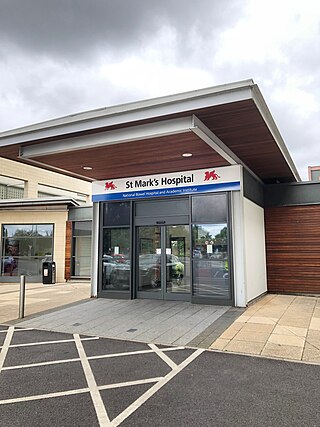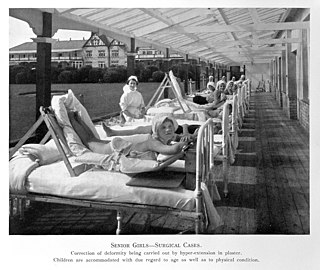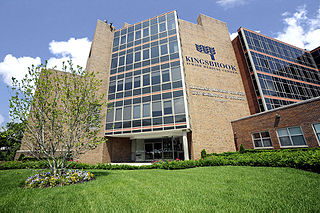
Tuberculosis (TB), also known colloquially as the "white death", or historically as consumption, is an infectious disease usually caused by Mycobacterium tuberculosis (MTB) bacteria. Tuberculosis generally affects the lungs, but it can also affect other parts of the body. Most infections show no symptoms, in which case it is known as latent tuberculosis. Around 10% of latent infections progress to active disease which, if left untreated, kill about half of those affected. Typical symptoms of active TB are chronic cough with blood-containing mucus, fever, night sweats, and weight loss. Infection of other organs can cause a wide range of symptoms.

The Royal London Hospital is a large teaching hospital in Whitechapel in the London Borough of Tower Hamlets. It is part of Barts Health NHS Trust. It provides district general hospital services for the City of London and Tower Hamlets and specialist tertiary care services for patients from across London and elsewhere. The current hospital building has 1248 beds and 34 wards. It opened in February 2012.

The Children's Hospital of Philadelphia, also known by its acronym CHOP, is a children's hospital in Philadelphia, Pennsylvania. Its primary campus is located in the University City neighborhood of West Philadelphia on the campus of the University of Pennsylvania. The hospital has 594 beds and more than one million outpatient and inpatient visits annually. It is one of the world's largest and oldest children's hospitals and the first hospital in the United States dedicated to the healthcare of children.

Monash Medical Centre (MMC) is a teaching hospital in Melbourne, Australia. It provides specialist tertiary-level healthcare to the Melbourne's south-east.

Swanley is a town and civil parish in the Sevenoaks District of Kent, England, 16 miles (26 km) southeast of central London, adjacent to the Greater London boundary and within the M25 motorway periphery. The population at the 2021 census was 17,826.

Sir Archibald Edward Garrod was an English physician who pioneered the field of inborn errors of metabolism. He also discovered alkaptonuria, understanding its inheritance. He served as Regius Professor of Medicine at the University of Oxford from 1920 to 1927.

The Royal National Orthopaedic Hospital (RNOH) is a specialist orthopaedic hospital located in Stanmore in the London Borough of Harrow, run by the Royal National Orthopaedic Hospital NHS Trust. It provides the most comprehensive range of neuro-musculoskeletal health care in the UK, including acute spinal injury, complex bone tumour treatment, orthopaedic medicine and specialist rehabilitation for chronic back pain. The RNOH is a major teaching centre and around 20% of orthopaedic surgeons in the UK receive training there.

Lupus vulgaris are painful cutaneous tuberculosis skin lesions with nodular appearance, most often on the face around the nose, eyelids, lips, cheeks, ears and neck. It is the most common Mycobacterium tuberculosis skin infection. The lesions may ultimately develop into disfiguring skin ulcers if left untreated.

Cincinnati Children's Hospital Medical Center (CCHMC) is an academic pediatric acute care children's hospital located in the Pill Hill neighborhood of Cincinnati, Ohio. The hospital has 652 pediatric beds and is affiliated with the University of Cincinnati Academic Health Center. The hospital provides comprehensive pediatric specialties and subspecialties to pediatric patients aged 0–21 throughout southern Ohio and northern Kentucky, as well as patients from around the United States and the world. Cincinnati Children's Hospital Medical Center also treats adults, including adults with congenital heart disease and young adults with blood disease or cancer. Cincinnati Children's Hospital Medical Center also features a Level 1 Pediatric Trauma Center, 1 of 4 in the state. Cincinnati Children's is home to a large neonatology department that oversees newborn nurseries at local hospitals around Ohio. The hospital features an AAP verified 89-bed Level IV (highest possible) Newborn Intensive Care Unit.

Stockwood Park is a large urban park in Luton, Bedfordshire, in the Farley Hill estate. With period formal gardens, leading crafts museums, Stockwood Park Rugby Club and extensive golfing facilities, it is about 100 hectares in area.

Chelsea and Westminster Hospital is a 430-bed teaching hospital located in Chelsea, London. The hospital has a rich history in that it serves as the new site for the Westminster Hospital. It is operated by Chelsea and Westminster Hospital NHS Foundation Trust, and became a member of Imperial College Academic Health Science Centre in July 2020. The hospital is the central part of Imperial College London Chelsea and Westminster Campus, and plays an integral role in teaching students and medical research at Imperial College London.

St Mark's Hospital, The National Bowel Hospital is a hospital in Park Royal, Greater London, England. Managed by London North West University Healthcare NHS Trust, it is the only hospital in the world to specialise entirely in intestinal and colorectal medicine and is a national and international referral centre for intestinal and colorectal disorders. It is the only hospital in the UK, and one of only 14 worldwide, to be recognised as a centre of excellence by the World Organisation of Digestive Endoscopy.

The Royal Alexandra Hospital (RAH) is a large and long serving hospital in the Canadian province of Alberta. Operated by Alberta Health Services and located north of Edmonton's downtown core, the Royal Alexandra serves a diverse community stretching from Downtown Edmonton to western and northern Canada. The total catchment area for the RAH is equivalent to 1/3 of Canada's land mass, stretching north from Downtown Edmonton to enpass both the Northwest Territories and Yukon territory, and stretching as far west as British Columbia's pacific coast.

East Tennessee Children's Hospital is a private, independent, not-for-profit, 152-bed pediatric medical center in Knoxville, Tennessee. The hospital's primary service area includes 16 counties in East Tennessee, and its secondary service area includes counties in southwest Virginia, southeast Kentucky and western North Carolina.

The Indian hospitals were racially segregated hospitals, originally serving as tuberculosis sanatoria but later operating as general hospitals for indigenous peoples in Canada which operated during the 20th century. The hospitals were originally used to isolate Indigenous tuberculosis patients from the general population because of a fear among health officials that "Indian TB" posed a danger to the non-indigenous population. Many of these hospitals were located on Indian reserves, and might also be called reserve hospitals, while others were in nearby cities.
Government Hospital of Thoracic Medicine, popularly known as the Tambaram TB Sanatorium, is a major state-owned hospital situated in Chennai, India. The hospital is funded and managed by the state government of Tamil Nadu. It was founded in 1928.

The former Dispenser's House of Diamantina Hospital is now the heritage-listed Diamantina Health Care Museum at Cornwall Street, Woolloongabba, City of Brisbane, Queensland, Australia. It was designed by Thomas Pye of the Queensland Government Architect's Office and built in 1908 by W Chaplain. It was added to the Queensland Heritage Register on 3 July 2007.

Stannington Sanatorium was the first purpose-built children's tuberculosis sanatorium in the UK which officially opened on 5 October 1907 near to the village of Stannington, Northumberland. The institution was established by a local charity, The Poor Children's Holiday Association (PCHA), which developed into the modern-day charity Children North East, and also took contributions from local Poor Law Guardians for the upkeep of patients.

Kingsbrook Jewish Medical Center was a 303-bed full-service community teaching hospital with an estimated 2,100 full-time employees, located in the neighborhood of East Flatbush in Brooklyn, New York. The hospital was made up of a complex of eight conjoined buildings which are dispersed over a 366,000 square foot city block.

Catherine Jane Wood was an English nurse, collaborator to Charles West in the early years of the Great Ormond Street Hospital, London, and pioneer of pediatric nursing.



















